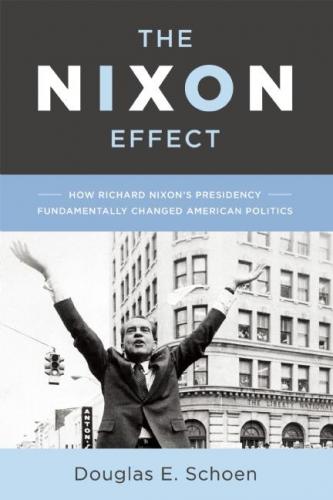Put another way: Few presidents have run more provocative, polarizing campaigns, yet few presidents have achieved more centrist, mainstream policy goals. It is a paradox worthy of Nixon himself.
However one understands it, there is no denying the impact of the Southern strategy on Nixon’s electoral fortunes. Despite the candidacy of the Southern populist and segregationist governor of Alabama George Wallace—whose appeal to whites was overt and enormously polarizing—the Southern strategy was astonishingly successful for Nixon in both 1968 and 1972. While Wallace took the Deep South (and many working-class votes in the North27), Nixon captured Virginia, North and South Carolina, Kentucky, Tennessee, Missouri, Oklahoma, and Florida.28 In 1972, Nixon won the entire South, along with the rest of the country except Massachusetts and the District of Columbia.29 The Democrats had lost their Solid South—and with it, their lock on the White House, which they had comfortably held for twenty-eight of thirty-six years before 1968.
Moreover, the Southern strategy would survive Nixon and become, with modifications, the guiding electoral model for the Republican Party up to the present day.
The Southern Strategy since 1968
It would be difficult to think of a political strategy that has had a longer “tail” in American politics than the Southern strategy. The strategy first identified, and then shaped, the most enduring political realignment since Franklin Roosevelt’s New Deal Coalition. Consider how it has played out in elections since 1968.
Democrats have won the Deep South in a presidential election only once since Nixon—in 1976, when Watergate and Gerald Ford’s pardon of Nixon helped propel Jimmy Carter into the White House. Democrats—notably Bill Clinton—have managed to pick off some Deep Southern states, but they have never won the region outright. In all the election cycles since 2000, they have been shut out entirely in the Deep South.
The move to the South that Goldwater started and Nixon completed was locked in by Ronald Reagan—a fitting inheritor of the strategy since he had been a Goldwater supporter in 1964 and given a powerful televised speech that helped launch his own political career. When Reagan came within a whisker of taking the 1976 GOP nomination from President Gerald Ford, he built his base of support with primary victories in Southern states, starting in North Carolina. And he famously, or infamously, launched his 1980 campaign at the Neshoba County Fair in Philadelphia, Mississippi—the same town where three civil rights workers had been killed in 1964. Reagan spoke that day mostly about the economy, but he also expressed his support for “states’ rights.” Liberals ever since have branded the episode as an explicit appeal to Southern racism. But Reagan and his campaign team were trying to win Mississippi, which the GOP had lost in 1976, while also hoping to build stronger black support. Reagan’s appearance there, like Nixon’s Southern strategy itself, is more complex than usually portrayed.
If anything, the contours of the Southern strategy have only hardened in the years since Reagan, and they have affected far more than electoral math. They shape the communications and dialogue of presidential campaigns. For Democrats, Republican appeals to white Southerners are often dismissed as “dog whistles”—that is, as coded language or imagery that speaks to the concerns of Southern whites, concerns which include, however subtly, racist connotations. Republicans, on the other hand, see these appeals as both legitimate—they point out that Southern whites are a voting bloc like any other and deserve consideration—and more broad minded than Democrats allege.
A case in point for the negative interpretations is the 1988 George H. W. Bush campaign ad concerning the convicted murdered and rapist Willie Horton. At that time Bush was engaged in a difficult presidential campaign against the Democratic nominee, Massachusetts governor Michael Dukakis. At one point in the summer, Bush trailed Dukakis in polls by seventeen points, but by early fall he had pulled even and then begun pulling ahead. The race still looked competitive in early October, when an independent Republican group ran the most provocative campaign ad since Nixon’s “We will have order in America” spot in 1968. The ad showed the mug shot of a frightening-looking man who happened to be black—Willie Horton, a convicted murderer serving a life sentence, who had nonetheless been granted a weekend furlough from prison in Dukakis’s Massachusetts. He didn’t return from furlough; instead, he raped a woman and stabbed her fiancée, whom he bound throughout the ordeal, before finally being recaptured.
“Weekend furloughs for convicted murderers,” the ad warned. “Dukakis on crime.”
Liberals howled that the ads were racist, using the mug shot to tap into white fears of black crime. Republicans countered that Dukakis’s furlough policy—which he had inherited from a predecessor and kept in place—was highly relevant, a part of his record and an insight into his priorities. Implicit in the ad was a conservative critique of the weak-willed liberalism that Dukakis seemed to embody.30
The Horton ad proved especially potent in the South, reminding Southern voters of the racial violence of the 1960s and 1970s. Bush’s campaign manager, the always-acerbic Lee Atwater, called the Horton ad campaign “a wonderful mix of liberalism and a big black rapist.”31 Bush beat Dukakis in a near landslide, winning forty states.
Конец ознакомительного фрагмента.
Текст предоставлен ООО «ЛитРес».
Прочитайте эту книгу целиком, купив полную легальную версию на ЛитРес.
Безопасно оплатить книгу можно банковской картой Visa, MasterCard, Maestro, со счета мобильного телефона, с платежного терминала, в салоне МТС или Связной, через PayPal, WebMoney, Яндекс.Деньги, QIWI Кошелек, бонусными картами или другим удобным Вам способом.
